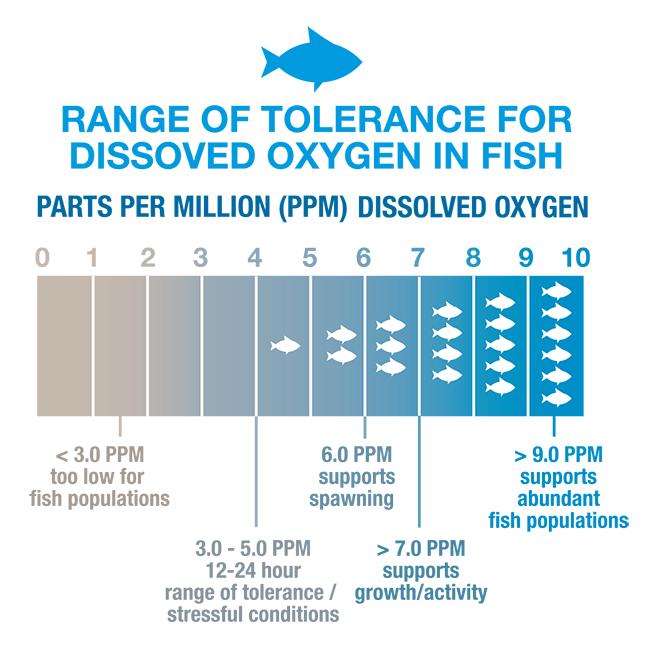What is Dissolved Oxygen?
Recent Sponsors for this Portal
B.F. Environmental Consultants Inc.
Water Testing Kits - Do It Yourself at Home !
USE our Water Quality Index Calculator for Surface Water !
Dissolved Oxygen in a stream may vary from 0 mg/l to 18 mg/l. Readings above 18 mg/l are physically impossible.
Dissolved oxygen gets into the water by diffusion from the atmosphere, aeration of the water as it tumbles over falls and rapids, and as a waste product of photosynthesis.
What factors affect the DO level?
- Reduced DO levels in stream water may be because the water is too warm. The increased molecular activity of the warm water pushes the oxygen molecules out of the spaces between the moving water molecules.
- Decreased DO levels may also be indicative of too many bacteria and an excess amount of biological oxygen demand - BOD (untreated sewage, partially treated sewage, organic discharges, anoxic discharges) which use up DO.
- A third reason for decreased DO may be fertilizer runoff from farm fields and lawns. The same fertilizer which was meant to make land plants grow better now makes the aquatic plants do the same. If the weather becomes cloudy for several days, respiring plants will use much of the DO while failing to photosynthesize. When the increased numbers of aquatic plants eventually die, they support increasing amounts of bacteria which use large amounts of the dissolved oxygen.

Water Quality Index Chart- Based on Dissolved Oxygen

Water Quality Index and BOD - Biological Oxygen Demand
Featured Testing Kits
Dissolved Oxygen Test Kit
Temperature and ORP Sensor
Earth Force Low Cost Monitoring Kits
Students should be aware that plants, in general, only produce oxygen when light is available for photosynthesis. Rooted aquatic plants are more abundant in lakes and impounded rivers than in rivers with significant current or in streams. Large daily fluctuations in dissolved oxygen are characteristic of bodies of water with extensive plant growth. DO levels rise from morning through the afternoon as a result of photosynthesis, reaching a peak in late afternoon. Photosynthesis stops at night, but plants and animals continue to respire and consume oxygen. As a result, DO levels fall to a low point just before dawn. Dissolved oxygen levels may dip below 4 mg/l in such waters - the minimum amount needed to sustain warm water fish like bluegill, bass, and pike.
How dissolved oxygen affects aquatic life.
The amount of DO an aquatic organism needs depends upon its species, the temperature of the water, pollutants present, and the state of the organism itself (adult or young, active or dormant).

A trout needs five to six times more DO when the water temperature is 24 degrees C (75 degrees F) as compared to when the water temperature is 4 degrees C (41 degrees F). The increased DO is needed to support an increase in metabolic rates - a phenomenon shared by other cold-blooded aquatic animals.
The generally accepted minimum amount of DO that will support a large population of various fishes is from 4 to 5 mg/l. When the DO drops below 3 mg/l, even the hardy fish die. Keep in mind that even though there may be enough DO to keep an adult alive, reproduction may be hampered by the need for higher DO for eggs and immature stages. Depletion in DO can cause major shifts in the kinds of aquatic organisms found in water bodies. Species that cannot tolerate low levels of DO - mayfly nymphs, stonefly nymphs, and beetle larvae - will be replaced by a few kinds of pollution-tolerant organisms, such as worms and fly larvae. Nuisance algae and anaerobic organisms (that live without oxygen) may also become abundant in waters with low levels of DO.
The following will give you some idea of how various fish species differ in their DO requirements:
Lowest DO at which fish survived for 24 hours (Summer)
Northern Pike - 6.0 mg/L
Black Bass - 5.5 mg/L
Common Sunfish - 4.2 mg/L
Yellow Perch - 4.2 mg/L
Black Bullhead - 3.3 mg/L
Certain pollutants interfere with oxygen uptake and metabolism so that some species of aquatic animals may need higher DO levels when these pollutants are present.
Student Projects and Science Fairs
Test Assured Options
Lamotte Surface Water Monitoring Kits
USE our Water Quality Index Calculator for Surface Water !
Training Courses- Water Resource Issues






